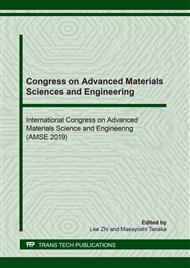[1]
Wang, Zhijun, et al. A white emitting phosphor BaMg2(PO4)2: Ce3+, Mn2+, Tb3+: luminescence and energy transfer., Ceramics International 40.9 (2014): 15283-15292.
DOI: 10.1016/j.ceramint.2014.07.026
Google Scholar
[2]
Long, Sheng, et al. High quantum efficiency red-emission tungstate based phosphor Sr (La1−x Eux)2Mg2W2O12 for WLEDs application., Ceramics International 39.5 (2013): 6013-6017.
DOI: 10.1016/j.ceramint.2013.01.013
Google Scholar
[3]
Spassky, D. A., et al. Electronic structure and luminescence mechanisms in ZnMoO4 crystals., Journal of Physics: Condensed Matter 23.36 (2011): 365501.
Google Scholar
[4]
Zhou, Yu, et al. Phase transition and photoluminescence properties of Eu3+-doped ZnMoO4 red phosphors., Science China Technological Sciences 60.10 (2017): 1473-1479.
DOI: 10.1007/s11431-017-9086-1
Google Scholar
[5]
Zhou, Li-Ya, et al. A potential red phosphor ZnMoO4: Eu3+ for light-emitting diode application., Journal of Solid State Chemistry 181.6 (2008): 1337-1341.
DOI: 10.1016/j.jssc.2008.03.005
Google Scholar
[6]
Kim, Myeong-Jin, and Young-Duk Huh. Synthesis and optical properties of CaMoO4: Eu3+, Na+ nanophosphors and a transparent CaMoO4: Eu3+, Na+ suspension., Optical Materials 35.2 (2012): 263-267.
DOI: 10.1016/j.optmat.2012.08.012
Google Scholar
[7]
Bharat, L. Krishna, Soo Hyun Lee, and Jae Su Yu. Synthesis, structural and optical properties of BaMoO4: Eu3+ shuttle like phosphors., Materials Research Bulletin 53 (2014): 49-53.
DOI: 10.1016/j.materresbull.2014.02.002
Google Scholar
[8]
Wei, Qiong, and Donghua Chen. Luminescent properties and the morphology of SrMoO4: Eu3+ powders synthesized via combining sol-gel and solid-state route., Open Physics 8.5 (2010): 766-770.
DOI: 10.2478/s11534-009-0098-5
Google Scholar
[9]
Hu, Daqiang, et al. Preparation and investigation of Eu3+-activated ZnMoO4 phosphors for white LED., Journal of Materials Science: Materials in Electronics 26.9 (2015): 7290-7294.
DOI: 10.1007/s10854-015-3356-x
Google Scholar
[10]
Ran, Weiguang, et al. Enhanced energy transfer from Bi3+ to Eu3+ ions relying on the criss-cross cluster structure in MgMoO4 phosphor., Journal of Luminescence 192 (2017): 141-147.
DOI: 10.1016/j.jlumin.2017.06.039
Google Scholar
[11]
Han, C. L., et al. Synthesis and luminescence properties of ZnMoO4: Eu3+, M+(M+= Li+, Na+ and K+) phosphors., Journal of Materials Science: Materials in Electronics 28.5 (2017): 4409-4413.
DOI: 10.1007/s10854-016-6069-x
Google Scholar
[12]
Oudghiri-Hassani, Hicham, et al. Preparation and characterization of α-Zinc molybdate catalyst: Efficient sorbent for methylene blue and reduction of 3-nitrophenol., Molecules23.6 (2018): 1462.
DOI: 10.3390/molecules23061462
Google Scholar
[13]
Xie, An, et al. Enhanced red emission in ZnMoO4: Eu3+ by charge compensation., Journal of Physics D: Applied Physics43.5 (2010): 055101.
Google Scholar
[14]
Abrahams, S. C. Crystal Structure of the Transition‐Metal Molybdates and Tungstates. III. Diamagnetic α‐ZnMoO4., The Journal of Chemical Physics 46.6 (1967): 2052-2063.
DOI: 10.1063/1.1841001
Google Scholar
[15]
Gall, Philippe, and P. Gougeon. The scheelite-type europium molybdate Eu0.96MoO4., Acta Crystallographica Section E: Structure Reports Online 62.5 (2006): i120-i121.
DOI: 10.1107/s1600536806012803
Google Scholar
[16]
Ran, Weiguang, et al. Remote Control Effect of Li+, Na+, K+ Ions on the Super Energy Transfer Process in ZnMoO4: Eu3+, Bi3+ Phosphors., Scientific reports 6 (2016): 27657.
DOI: 10.1038/srep27657
Google Scholar
[17]
Wood, D. L., and J. S. Tauc. Weak absorption tails in amorphous semiconductors., Physical Review B 5.8 (1972): 3144.
DOI: 10.1103/physrevb.5.3144
Google Scholar
[18]
Zhai, Bao-gai, et al. Growth of ZnMoO4 nanowires via vapor deposition in air., Materials Letters 188 (2017): 119-122.
Google Scholar
[19]
Cao, Renping, et al. Synthesis, luminescence properties, and energy transfer of novel CaWO4: Eu3+, Mn2+ red phosphor., Superlattices and Microstructures 88 (2015): 5-11.
DOI: 10.1016/j.spmi.2015.08.025
Google Scholar
[20]
Zhai, Bao-gai, et al. Effects of Sintering Temperature on the Morphology and Photoluminescence of Eu3., Journal of Nanomaterials 2018 (2018).
Google Scholar
[21]
Cavalcante, Laécio S., et al. A combined theoretical and experimental study of electronic structure and optical properties of β-ZnMoO4 microcrystals., Polyhedron 54 (2013): 13-25.
DOI: 10.1016/j.poly.2013.02.006
Google Scholar


